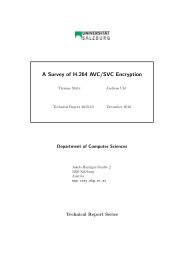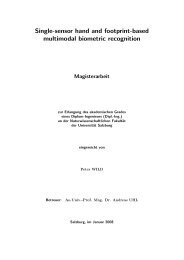Pit Pattern Classification in Colonoscopy using Wavelets - WaveLab
Pit Pattern Classification in Colonoscopy using Wavelets - WaveLab
Pit Pattern Classification in Colonoscopy using Wavelets - WaveLab
Create successful ePaper yourself
Turn your PDF publications into a flip-book with our unique Google optimized e-Paper software.
4 Automated pit pattern classification<br />
4.3.2.4 The mapp<strong>in</strong>g function<br />
To construct the mapp<strong>in</strong>g function U from section 4.3.2.2, which maps a vertex v i to a<br />
unique number u i , we use the formula<br />
u i =<br />
M∑<br />
5 j p j where p j ∈ P vi (4.36)<br />
j=1<br />
where M is the number of nodes along the path to the node v i . j is noth<strong>in</strong>g more than the<br />
depth level <strong>in</strong> the tree of the j-th node <strong>in</strong> the path to node v i . Hence equation (4.36) is just<br />
a p-adic number with p = 5 which is a unique representation of a number with base 5.<br />
Base 5 is required s<strong>in</strong>ce at each node there are four possible ways to traverse down the tree.<br />
If we used base 4 we would only have the digits 0 to 3, which is not useful s<strong>in</strong>ce this would<br />
result <strong>in</strong> a tree with multiple nodes hav<strong>in</strong>g a unique id of 0.<br />
To ensure that every u i is unique for all v i ∈ V the requirement that a path sequence<br />
P vi for a node v i must be unique among the quadtree must be met. And s<strong>in</strong>ce a quadtree<br />
conta<strong>in</strong>s no cycles and every node <strong>in</strong> a tree has only one parent node, this requirement is<br />
met.<br />
4.3.2.5 The metric<br />
We are now able to express the similarity between to quadtrees by measur<strong>in</strong>g the distance<br />
between them. Distance, <strong>in</strong> this context, is a function d(T 1 , T 2 ) which returns the real valued<br />
distance between two quadtrees T 1 and T 2 , which are elements of the so-called metric set T.<br />
More formally this can be written as<br />
d : T × T −→ R (4.37)<br />
Now the follow<strong>in</strong>g properties for metrics hold for all T 1 , T 2 ∈ T:<br />
d(T 1 , T 2 ) > 0 ⇔ T 1 ≠ T 2 (4.38)<br />
d(T 1 , T 2 ) = 0 ⇔ T 1 = T 2 (4.39)<br />
d(T 1 , T 2 ) = d(T 2 , T 1 ) (4.40)<br />
Therefore this distance between two quadtrees can be used to express the similarity between<br />
two quadtrees.<br />
46








